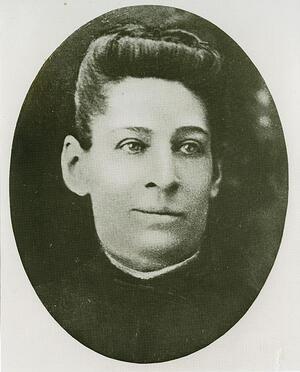Construction begins on Denver hospital inspired by Frances Wisebart Jacobs
Volunteer, social worker, and founder of Hebrew Ladies’ Relief Society and the Denver Ladies’ Relief Society, Frances Wisebart Jacobs (1843–1892).
Image courtesy of Beck Archives, Special Collections, Penrose Library and CJS, University of Denver. This image is in the public domain.
Construction on a building that was to be called the Frances Wisebart Jacobs Hospital and is now known as the National Jewish Medical and Research Center, began in Denver on October 9, 1892. Frances Jacobs, known as Colorado's "Mother of Charity," devoted her life to community service. She is the only woman included among the sixteen Colorado pioneers depicted through stained glass portraits in the state's Capital Rotunda.
Born in Kentucky and raised in Cincinnati, Jacobs moved with her husband to Colorado in 1863; they settled in Denver in 1870. Jacobs quickly became involved in Denver’s Jewish and non-Jewish communities. By 1872, Jacobs had helped to organize and was serving as president of the Hebrew Ladies’ Benevolent Society. In 1874, she helped found the nonsectarian Denver Ladies’ Relief Society. She worked for the creation of Denver’s first kindergartens and, together with leading Christian clergymen, helped organize Denver’s Charity Organization Society, a forerunner to the United Way, in 1877.
Jacobs also pushed the Denver Jewish community to attend to the care of the many Jewish tuberculosis sufferers who came to Denver. At that time, the only known treatment for tuberculosis was clean air and sunshine; since Denver had both of these resources in abundance, it became a popular destination for infected immigrants from the industrial Northeast. When these immigrants arrived in Denver, they found no facilities available to treat or even shelter them, and the community ignored their plight.
Jacobs did her best to help those who were ill on an individual basis, but worked to convince the Jewish community to help, leading to the construction of the hospital, whose motto became “None may enter who can pay, and none can pay who enter.”
Jacobs died at the age of 49, just a few weeks after construction on the hospital had commenced, from pneumonia she contracted during a visit to an impoverished family. Her death was mourned by a broad spectrum of the Denver community and the Rocky Mountain News which noted "She knew no creed or denomination when a cry of distress was heard." In her memory, the hospital trustees voted to name the hospital after her.
The hospital did not actually open, however, until 1899 after an extensive fund-raising campaign conducted by the B'nai B'rith. In recognition of its national scope it opened under the name of National Jewish Hospital. Today the institution is the leading medical and research center in the United States devoted entirely to respiratory, allergic, and immune system diseases, appearing in the news whenever there is a prominent case of T.B..
To learn more about Frances Wisebart Jacobs, visit Jewish Women: A Comprehensive Historical Encyclopedia.
Sources:Jewish Women In America: An Historical Encyclopedia, pp. 684-685; National Jewish Health; Jeanne E. Abrams, Jewish Women Pioneering the Frontier Trail: A History in the American West (New York, 2006).




I have read up your article very attentively and i must say this is an informative detail which you have shared in it. I am quite sure this would become massive detail for those who love history but hope to share this one with my mom who loves to read such as stuff always.Now, like to take Washington guided tours.
My late husband was encouraged to go to the hospital by his physicians in Boston so that he could have a second opinion about his emphysema/COPD. The hospital was all that one could have wished: meticulous and eager to make a long series of examinations as easy and comfortable as possible. I did notice the photos of Frances Jacobs and other Jewish women in the halls of the hospital, and felt pleased that I understood more about them thanks to the Jewish Women's Archive.
Dear LEAH,
Although various newcomers to Denver are enchanged with the story of Frances Jacobs and the National Jewish Hospital, she had nothing to do with it. I go into quite a bit of detail in my book, PIONEERS, PEDDLERS AND TSADIKIM, still in its 3rd Edtion but available only Print On Demand from the University Press of Colorado. Pages 118-124 are more detailed tan the account above,
Wisebart believed that charity should come from all for all. This was her guide in activity as a founder of the organization in Denver that led to today's United way. She was not involved in the National Jewish Hospital. The original hospital was named for her on her death because of her prominence. It was thought to bring in funds from the non-Jewish community as well as the Jewish. 1893 was a panic year and there were no funds. The building was idle until 1899 when Bnai Brith took over under the name the National jewish Hospital.
Abraham Jacobs, her husband was a 59er. The family was prominent. I found that they were the only Jews invited to the parties given by Helen Barnum Buchtel, the daughter of P.T. in my research for my book, Howdy, Sucker! What PTBarnum Did in Colorado.
I would write more, but I lost two of these accounts. When I hear that you received this one, I will send further corrections.
Sincerely,
ida Uchlll